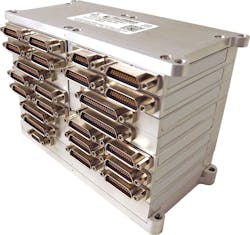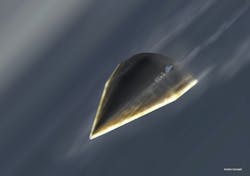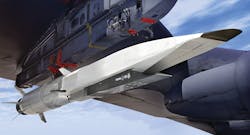Contrary to popular opinion, there is nothing new about hypersonic flight.
Nazi Germany’s V-2 rocket achieved speeds of Mach 5, but was not called hypersonic, a term not coined until 1946 by Hsue-shen Tsien, an aerodynamicist at the California Institute of Technology.
In 1949, the two-stage Bumper rocket achieved a speed of Mach 6.7 before burning up on atmospheric reentry. Yuri Gargarin became the first human to travel at hypersonic speed during his historic orbital flight in 1961. The following month, Alan Shepard joined that unique club when his suborbital flight exceeded Mach 5 on reentry. And in November that year, Air Force Maj. Robert White exceeded Mach 6 in the X-15 research plane. Ballistic missiles routinely reach speeds of up to Mach 9 during reentry from space; the Space Shuttle, dropping out of orbit, entered the atmosphere at roughly Mach 22.
However, these examples were largely short-term and on fixed trajectories, while hypersonic missiles follow unpredictable and adjustable flight paths, placing variable and far greater environmental pressures on electronic components and sensors needed for their successful operation.
Aircraft moving through the atmosphere at speeds exceeding Mach 5 (roughly 3,800 miles per hour, depending on altitude) challenge engineers with extraordinary levels of heat, vibration, and shock.
The need for rugged
The technologies for ruggedization include enhanced circuit board design and component selection; screening components; and ensuring that electronic parts will survive the vibration, temperature, and pressure extremes of hypersonic flight.
“Matching and overcoming hypersonic threats will demand technology advances across three broad areas: propulsion systems; airframe materials; embedded electronics,” wrote Lorne Graves, chief technology officer of rugged computer specialist Abaco Systems in Huntsville, Ala., in a March 2019 white paper. “While most research spending is targeting the first two areas, it is clear that innovative improvements in embedded electronics are key to creating fully functional hypersonic systems.”
He identified four primary functions embedded electronics that will need to perform for deployable hypersonic platforms:
- mission computing, focused on responding to commands, adjusting to changing conditions and ensuring that all subsystems work in concert to accomplish a platform’s mission;
- flight computing, controlling the path of the platform, monitoring the outputs of sensors and controlling the operational employment of sensors;
- real-time signal processing for radar, electro-optical sensors, and electronic warfare (EW); and
- flawless and secure communications with command and control networks.
Efforts to overcome those difficulties continue to be the focus of numerous research programs in the U.S., Russia, China, France, India, Australia, and Japan. From military labs to academia to private companies, new technologies are being developed, old technologies modified, and revolutionary designs tested to address the issues facing hypersonic missile engineers.
Pressure on circuit boards
“Traveling at those speeds, the vibration profiles will evolve beyond what typical standards currently call for, so you have a lot of work to do on printed circuit boards, all the separable connector failure points and mitigating the effects of those so you don’t have failures, either right away or fatigue failures, which are worse,” says Ivan Straznicky, chief technology officer for advanced packaging at Curtiss-Wright Defense Solutions in Ashburn, Va.
“Heat is another area,” Straznicky continues. “If a missile goes back into the atmosphere at those speeds, it generates a lot of heat, so we need materials to shield against that. But you can’t get rid of that heat entirely, so it will be hot inside that missile. You need electronics that can survive above typical temperature ranges, which may require unique solutions, such as vapor chambers or perhaps some type of liquid cooling.”
Experts say they will have to design components to withstand environmental conditions as severe as 10 times higher than the maximum allowed under VITA 47 — an American National Standard that defines rugged environmental, design, and construction requirements for rugged commercial-off-the-shelf (COTS) plug-in embedded computing boards. Still, there is no ruggedization “silver bullet” to protect hypersonic electronics and sensors.
“There are potentially flight versus mission computers on the platforms, which may have very different requirements,” Straznicky points out. “The flight computer may need be certified to DO-25 4 DAL A [the most stringent design assurance level for airborne electronics], which is a high bar. Mission computers still need to be ruggedized, to the same level, but the design assurance levels impose significant additional restrictions on the hardware, such as recognizing failure modes.”
Manufacturing also can be a challenge. “Components are no longer made specifically for military applications, but predominantly for commercial,” Straznicky explains. “A lot of component manufacturers do have industrial, sometimes military, temperature characteristics, but those are few. When you design those in and assemble them onto a printed circuit board, then put cooling systems on top of that, everything needs to work reliably, such as solders. That’s a fairly esoteric specialty for ruggedization.”
It also is a problem researchers and engineers have been studying for decades. At the end of an October 1967 flight that reached Mach 6.7, the X-15 suffered intense heating from shock waves that partially melted the pylon that attached the aircraft’s ramjet engine to the fuselage. While external heat is a problem for external structures, such as sensors, it also significantly raises the aircraft’s internal temperature, threatening to damage sensitive electronics.
Conformal coatings
Experts say that environmental ruggedization to protect electronics from heat at hypersonic speeds — exterior temperatures rising higher than 4000 degrees Fahrenheit — almost certainly will rely on conformal coatings.
“Whatever the actual shock and vibration levels and the actual environment, once released, we can work to those types of extremely harsh environments, even beyond current ruggedization requirements.”
The specific technologies used to ruggedize against heat and vibration also will vary throughout the vehicle, depending on where the electronics are installed. The nose, for example, will experience harsher temperatures than the tail.
Design engineers basically are using existing technologies and designs developed during the past three decades, modified to increase the ability to survive in those harsh environments, says Farhad Daghigh, vice president for sales and business development at the Curtiss-Wright Defense Solutions Aerospace Instrumentation Group.
Where sensors are installed also will impact the level of ruggedization required, such as the types of glues and fasteners used to attach them to the skin of the vehicle. The problem is two-fold — finding materials that can withstand both extreme temperatures, including a rapid transition from the cold of altitudes exceeding 100,000 feet to the intense heat of reentry and flight through the lower atmosphere, and intense shock and vibration.
Thus the true difficulty with developing a hypersonic missile is not pushing it to such high speeds, but ensuring the embedded computing systems can endure the extreme range of temperatures, G forces, vibration, humidity, and pyrotechnic shock — and do so without adding weight or bulk to the missile.
“Uncontrolled energies at resonant frequencies can rapidly destroy components and connections throughout an embedded computing system. Some hypersonic platform designs further complicate the mechanical vibration challenge by using an engine that varies its combustion behavior based on altitude,” says Abaco’s Graves.
“This innovative propulsion solution also means that the engine vibration characteristics will vary, further complicating embedded electronics designs,” Graves says. “Other environment considerations are not related to hypersonic speeds, but must still be accounted for, based on a given platform’s mission profile.”
Commercial electronics
In today’s high-tech environment — especially with the limited market of military hypersonics — application-specific developments solely for military use simply are not practical. Using the latest in rapidly advancing commercial computing and communications silicon to create the kind of powerful, multi-function computing required for hypersonic missions will have to suffice. But systems using commercial chips will have to be ruggedized far beyond civilian requirements to ensure survivability in the harshest environments.
“The AXIS Software Tool Suite from Abaco includes modules supporting the accelerated development of algorithm implementation, data movement, inter-process communications, image processing, event analysis and more capabilities. At the platform level, programs need powerful embedded electronics that can support all aspects of a mission, making software development a critical function.”
Yet even collaborative efforts among the top researchers and facilities can only go so far in the development of workable and, above all, reliable ways to deal with those problems. For high-speed aviation, validating ruggedization falls to the flight test stage of development.
“In the world of flight test, products have to be much more rugged than the design products for the operational stage of an aircraft. So we push the envelope much further than we would on an operational platform,” Curtiss-Wright’s Daghigh says.
“For an aircraft that typically flies at Mach 2, we push the tests to Mach 3,” Daghigh says. “For hypersonics, you have to push that even further; if it is supposed to go to Mach 8, we test it to Mach 9 or 10. In flight test, you’re in experimental mode and anything goes, which you have to be ready for because we are measuring thousands of sensors down to the nanosecond to see what happened across them all if something goes wrong at any one point. In the operational environment, they won’t take the aircraft beyond its design characteristics.”
In addition to the purely engineering problems facing hypersonic development, U.S. Department of Defense (DOD) also must keep a close eye on international developments, primarily from potential adversaries such as China and Russia, both of which have claimed to already have hypersonic capability, with missile ranges as far as 1200 miles.
World hypersonic development
Russian President Vladimir Putin has announced the Avangard hypersonic glide vehicle is “operational” and capable of speeds to Mach 27. The Chinese claim to have two hypersonic missiles: The DF-17, unveiled on 1 October 2019, and the Starry Sky-2, a Mach 6 hypersonic glide platform still under development.
Maintaining U.S. competitiveness in hypersonics involves not only watching Russian and Chinese developments, but also tracking trends in commercial processing and communications technology. That evaluation then leads to adopting the best examples of commercial technology across multiple processor types.
“Today’s processing silicon is segmented into technology types, including multi-core general purpose processors (GPPs), general purpose graphics processing units (GPGPUs), field programmable gate arrays (FPGAs), digital signal processors (DSPs) and communications processors (CPs),” Graves wrote.
“As the name suggests, a GPP is not specialized — and yet, for the purposes of embedded computing, it is. A GPP is the best processor type when decision-making and context-switching is important; for example, when responding to commands.”
Each advance in modern processors, however, increases one of the most pernicious problems with hypersonic flight — heat. Even as each new generation of processor provides geometric increases in performance, increases vital to the complex requirements of a hypersonic vehicle, the internal heat generated increases, as well. In recent years, however, there has been little change in the maximum operating temperatures of most commercial silicon, typically around 100 degrees Fahrenheit.
Cooling challenges
One of the most common methods of cooling such systems is blowing forced air over them, which obviously is not possible in hypersonic flight, where external heat also must be extirpated. That leaves two other primary techniques: conduction cooling and heat pipes, sometimes combined within an advanced system design.
Conduction cooling is implemented with a heat frame that encloses a circuit board where the processors are connected, and wedge locks that firmly attach the heat frame/circuit board assembly to a system chassis wall, Graves explains. The wedge locks also help address another problem — vibration — by increasing system rigidity.
“Vibration effects, as well as acceleration G forces and pyrotechnic shock, can all be mitigated by using damping materials at physical connection points, both within a system chassis and where the chassis is attached to the airframe,” according to Graves.
But the extremes to which hypersonic flight pushes all environmental requirements — especially at speeds in the Mach 20 to Mach 30 range envisioned for hypersonic missiles — means there must be significant advances in every component and every method used to defeat those challenges. Simulations are used to identify potential weaknesses in COTS components used in the design, then those are strengthened and secured to ensure they can withstand the hypersonic environment before they ever go on a flight test vehicle.
“It’s like a Lego concept where you can stack modules on top of each other, depending on the number of sensors and how big that configured stack is going to get, and ensure it will stay intact for the specific mission or if you will need additional work to hold it in place,” Daghigh says.
DARPA MACH program
The Materials Architectures and Characterization for Hypersonics (MACH) program at the U.S. Defense Advanced Research Projects Agency (DARPA) in Arlington, Va., comprises two technical areas. According to the agency, “the first seeks to develop and mature fully integrated passive thermal management systems to cool leading edges based on scalable net-shape manufacturing and advanced thermal design. The second will focus on next-generation hypersonic materials research, applying modern high-fidelity computation capabilities to develop new passive and active thermal management concepts, coatings and materials for future cooled hypersonic leading edge applications.”
“Cooling is interesting because you are trying to get heat off a very hot vehicle. SWaP [Size, Weight and Power] is important because these are very constrained platforms. Based on the aerodynamic principles involved and launch capabilities, you have a highly SWaP-constrained platform. So, advances in electronics, fuel and materials in general will be very important.”
Hypersonic weapons research received about $2 billion in 2020 and the Pentagon is asking to increase that to $3.2 billion in 2021. Those numbers reflect the status of hypersonics as the DOD’s number-one research priority, with strong bipartisan support in Congress and from the White House.
In addition to vehicle and propulsion designs, dozens of defense contractors, subcontractors, and research labs are devoting increasing levels of effort to hypersonics, including solving the environmental hazards facing such a missile’s electronics and sensors. For example, John Varley, vice president for hypersonics at the Lockheed Martin Corp. Missiles and Fire Control segment, has said Lockheed alone has about $3.5 billion in hypersonics work across several divisions.
Keeping up with adversaries
What the Chinese and Russians have done in that area is largely unknown (publicly, at least), but the United States and its allies have decades of experience in shielding such systems against heat, vibration, and shock. Those come largely from the space program, where hypersonic speeds are foundational, as well as military programs, from the X-15 to the Waverider.
While all three nations report testing hypersonics, no one has proven yet to have conquered those environmental challenges sufficiently for reliable and successful maneuverable flight.
That such a capability will be achieved in this decade seems almost certain, bringing in a new era of warfare as game-changing as the development of intercontinental ballistic missiles — especially when a hypersonic cruise missile carries a nuclear warhead, as Adm. Charles Richard, head of the U.S. Strategic Command, told a Senate Armed Services Committee hearing on 13 February.
“I will offer that it is not our policy or intent right now to nuclearize hypersonics,” he added. “Other nations can choose to do what they wish in that area and, yes, this is the competition.”
Able to strike a target anywhere on Earth in a matter of minutes, a functional long-range hypersonic missile’s speed and maneuverability also would make it virtually impossible for current missile shields to defend against. But the reality of this new “nightmare” weapon is entirely dependent upon radically advanced glues, solders, heat dissipation, anti-shock and anti-vibration protection for its most delicate internal components.
“This has a lot of similarities to the introduction to the intercontinental ballistic missiles back in the late Fifties and early Sixties and we are ready to address it,” Richard assured Congress.





